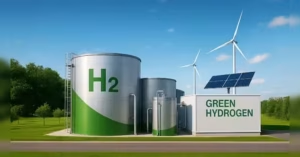Green Hydrogen

Green hydrogen refers to hydrogen gas produced through the process of water electrolysis powered entirely by renewable energy sources such as solar, wind, or hydropower. Unlike conventional hydrogen production methods that rely on fossil fuels, green hydrogen is considered a clean energy carrier because it generates no direct carbon emissions. It is increasingly viewed as a critical element in global strategies to achieve decarbonisation and long-term energy security.
Background and Context
Hydrogen has long been recognised as a versatile energy carrier with potential applications across industries, but its environmental impact depends heavily on the method of production. Traditional methods include:
- Grey hydrogen: Produced from natural gas through steam methane reforming, releasing carbon dioxide into the atmosphere.
- Blue hydrogen: Similar to grey hydrogen, but coupled with carbon capture and storage (CCS) technologies to reduce emissions.
- Brown/Black hydrogen: Derived from coal gasification, highly carbon-intensive.
Green hydrogen stands apart as it uses electrolysis to split water into hydrogen and oxygen, with renewable electricity ensuring that the process is carbon-free. This method provides a sustainable pathway to replace fossil fuel-based hydrogen and contribute to net-zero goals.
Production Process
The production of green hydrogen involves:
- Electrolysis – An electrolyser passes an electric current through water, separating it into hydrogen and oxygen.
- Renewable Energy Supply – Power is sourced from solar farms, wind turbines, or hydropower plants to ensure zero-carbon input.
- Storage and Distribution – Hydrogen can be stored under pressure, liquefied, or converted into carriers such as ammonia for easier transport.
Technological advancements are improving the efficiency of electrolysers, lowering costs, and enabling large-scale production facilities.
Applications
Energy and Industry
- Power generation: Hydrogen can be used in fuel cells or gas turbines to generate electricity.
- Transport: Fuel cell vehicles (cars, buses, trucks, trains, and ships) use hydrogen as a clean fuel alternative to fossil fuels.
- Industry: Hydrogen serves as a feedstock in steelmaking, refining, fertiliser production, and chemical industries, offering a route to decarbonise energy-intensive sectors.
- Energy storage: Hydrogen can store surplus renewable electricity, providing long-duration storage and balancing intermittent renewable power supply.
Emerging Uses
- Aviation: Research is underway to use hydrogen in aviation, either as a direct fuel or in synthetic e-fuels.
- Heating: Hydrogen can be blended into existing natural gas networks to decarbonise heating in residential and industrial contexts.
Advantages
- Carbon-free energy: When produced with renewable energy, green hydrogen is a zero-emission fuel.
- Versatility: It can be used across multiple sectors, from heavy industry to mobility.
- Energy security: It reduces dependence on imported fossil fuels, enabling domestic renewable-based hydrogen production.
- Storage capability: Provides a means of storing renewable energy at scale, overcoming intermittency challenges.
- Pathway to net-zero: Critical for decarbonising hard-to-abate sectors such as steel, cement, chemicals, and heavy transport.
Challenges
- High production cost: Green hydrogen remains more expensive than fossil fuel-derived hydrogen due to high costs of renewable energy and electrolysers.
- Infrastructure gaps: Limited infrastructure for storage, transport, and refuelling hinders widespread adoption.
- Efficiency losses: The process of converting renewable electricity into hydrogen and back into electricity involves energy losses.
- Water demand: Electrolysis requires significant amounts of purified water, posing challenges in water-stressed regions.
- Policy and investment: Large-scale deployment requires strong policy support, subsidies, and private investment.
Global Developments
Many countries have launched national hydrogen strategies and roadmaps to scale up production and create hydrogen economies. Notable examples include:
- European Union: Ambitious plans to become a global leader in green hydrogen, with projects tied to the EU Green Deal.
- Japan and South Korea: Early adopters of hydrogen fuel cell technologies for transport and energy systems.
- India: Launched the National Green Hydrogen Mission to become a major producer and exporter.
- Australia and Middle East: Investing heavily in large-scale hydrogen export hubs, leveraging abundant renewable resources.
Significance
Green hydrogen represents a transformative opportunity for the global energy transition. It provides a pathway to deep decarbonisation, particularly in sectors where direct electrification is difficult. By bridging the gap between renewable energy potential and industrial demand, it offers a strategic solution for achieving net-zero emissions, enhancing energy resilience, and driving sustainable economic growth.
As costs decline and infrastructure expands, green hydrogen is expected to play a pivotal role in shaping the future of global energy systems.




